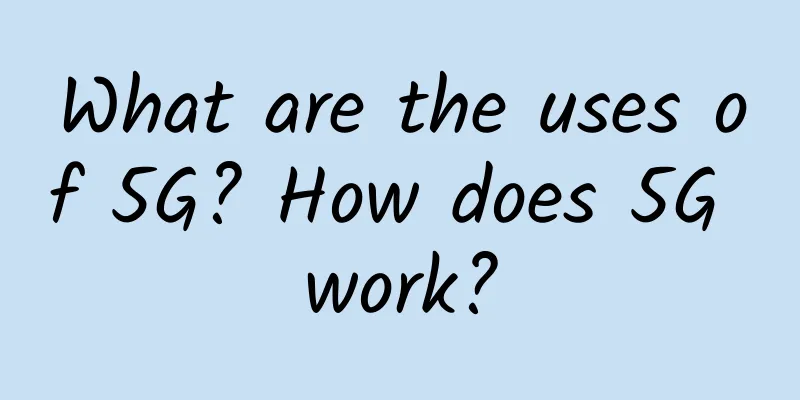The story of spectrum: Gigabit is just the beginning

|
At the end of 4G development, the most advanced modems have achieved a breakthrough in 1Gbps downstream transmission. In the field of communications, Gigabit is a milestone. Achieving Gigabit speed means that most bandwidth problems can be easily solved. Gigabit LAN makes it possible to store massive amounts of data remotely; Gigabit broadband makes 4K HDR video and VR video streaming feasible...
Gigabit wireless communication is obviously more attractive. Whether it is Gigabit communication in wireless WAN or Gigabit communication in LAN, many difficulties must be overcome. Let's take a look at how the Gbps barrier is broken at each network level. LTE Multi-Carrier Aggregation - The Starting Point of 4G Gigabit In the previous series of articles, we mentioned that the channel of wireless communication is the frequency band. Currently, under the 4G standard, there are more than 40 frequency bands used for 4G communication worldwide. Because the bandwidth of each frequency band has been pre-assigned and cannot be increased arbitrarily, the transmission rate of a single 4G LTE frequency band with a maximum bandwidth of 20MHz is far from reaching the gigabit level of 1Gbps. Therefore, gigabit transmission must be achieved through multi-carrier aggregation. However, for Qualcomm, carrier aggregation technology is not a difficult problem. As early as last year, Qualcomm's Snapdragon X16 LTE modem has combined four 20MHz LTE bands into a high-speed channel with the help of carrier aggregation technology, achieving a maximum downlink rate of 1Gbps at the Gigabit level; and this year, Qualcomm's X20 LTE modem has continued its efforts. Based on the Snapdragon X16 LTE modem, it has introduced several new Qualcomm technologies to support up to five 20MHz LTE band downlink carrier aggregation, with a maximum transmission rate of up to 1.2Gbps, ensuring that 1Gbps Gigabit Wireless Wide Area Network communication can be achieved in actual applications. Qualcomm has not only done simple mathematical addition on the Snapdragon X20 LTE modem, but also used a lot of exclusive technologies. First, 4 x 4 MIMO can be achieved in 3 of the 5 carrier aggregation bands, so that the transmission can be more stable and maintained at a higher speed level; secondly, it is an LTE-A Pro modem that supports Licensed Assisted Access (LAA). LAA enables operators to use licensed spectrum as low as 10 MHz to launch Gigabit LTE services, and further expands the range of supported frequency bands, making carrier aggregation and frequency band selection and allocation more flexible, and the aggregation frequency band combinations even exceed 1,000. The Snapdragon X20 LTE modem has achieved extreme speeds of over 1Gbps, stability, and availability, which means that gigabit-level 4G networks are now officially on the road, and that the most important cornerstone to 5G networks has also officially debuted. 802.11ac - the foundation of Gigabit wireless LAN After entering the mobile era, the number of devices using wireless LAN communication in the home has greatly increased. Compared with Gigabit LAN, which is usually only used by one desktop computer, Gigabit wireless LAN can obviously take care of everyone. Today, the outbound bandwidth of home networks is constantly expanding, from 10Mbps, 20Mbps, to hundreds of Mbps and even 1Gbps - however, without a Gigabit WIFI network, no matter how high the outbound bandwidth is, it will be useless and its appeal to users will be greatly reduced.
Therefore, the 802.11ac standard is designed to solve this problem. In the 5GHz band, wireless devices that support this standard can achieve a maximum transmission rate of 1300Mbps through 3×3 MIMO antennas. In the second version of the 802.11ac Wave 2 standard, 4×4 MIMO antennas push the theoretical speed limit to 1700Mbps. However, many users find it difficult to reach this speed limit in actual use, especially when there are many devices at home. Therefore, a technology called MU-MIMO congestion-free Wi-Fi was introduced in the 802.11ac Wave 2 standard. By allowing the router to communicate with multiple devices at the same time, it greatly improves the client carrying capacity of 802.11ac devices and improves the resource utilization of home networks. Qualcomm also plays an important role in this. Its QCA9984 solution is rooted in the motherboards of most of the current MU-MIMO congestion-free Wi-Fi routers. In order to give full play to the role of MU-MIMO congestion-free Wi-Fi, terminal devices such as mobile phones and tablets must also support MU-MIMO. Qualcomm can also take care of this for users - the Snapdragon mobile platform directly integrates modules that support MU-MIMO congestion-free Wi-Fi 802.11ac. Almost all flagship 8 series Snapdragon processor products can do this.
With the ever-increasing speed of 802.11ac and the congestion-free Wi-Fi multi-device coordination capability of MU-MIMO, various devices at home can harmoniously share the high-speed transmission experience brought by the gigabit wireless network. 5G and 802.11ad—Multi-gigabits are just around the corner However, we cannot be satisfied with this. LTE Gigabit and 802.11ac have just crossed the 1000Mbps threshold. Their capabilities are limited. If we want to achieve multi-gigabit transmission, we have to rely on the upcoming 5G communication standard and the 802.11ad ultra-high frequency wireless LAN that has already emerged. What is the 5G communication standard? This question requires the joint efforts of all participants in the communication industry to answer. People have proposed that the latency of the existing 4G LTE network will be greatly reduced, the signal coverage will be greatly enhanced, and the power consumption of the signal will be greatly reduced. The ultimate goal is to ensure that most people can break through the 1Gbps transmission speed at the same time. In addition, IoT and disaster prevention broadcasting use cases are also calling for the early arrival of 5G. 802.11ad is the 7Gbps ultra-high-speed transmission that ultra-short-distance applications such as VR are eagerly waiting for. Qualcomm is also trying to give its own answer. At present, they already have a lot of technical reserves and products: last year, it has already produced a 5G new air interface prototype system, which runs on channels below 6GHz, uses large-scale antenna array technology, and absorbs the original technical essence of the 4G era, OFDM, beamforming, etc., to optimize the performance of non-line-of-sight scenarios; after shortening the distance, Qualcomm also has a 5G millimeter wave OTA solution, which can achieve ultra-high data transmission rates within hundreds of meters, as well as a 28GHz end-to-end millimeter wave prototype, and even made a 60GHz band 32 antenna array for VIVE VR that supports the 802.11ad standard. Technologies such as carrier aggregation, beamforming, and MU-MIMO have played a crucial role in breaking through the 1Gbps barrier. After breaking through the shackles of 1Gbps at the gigabit level, what will we do with 5G networks? In the next spectrum story, we will look forward to the future of the Internet of Everything with you. |
<<: Huawei's "Government Cloud China Tour" has a unique scenery in Shaanxi
>>: The 400G era is coming, and new optical fibers may be the best partner
Recommend
Mobile performance optimization series - startup speed
Mobile performance has a crucial impact on user e...
CloudCone Chinese New Year Special Package, Los Angeles 1G memory VPS annual payment starts from $13.5
CloudCone has launched several special packages f...
SF Express's Liu Zhixin: Artificial intelligence helps logistics upgrade
[51CTO.com original article] On July 21-22, 2017,...
Hyper-converged data center network CloudFabric 3.0 builds a new data center network foundation
Recently, at the "ICT China High-level Forum...
AI chip black technology inventory
As big data and deep learning are increasingly us...
Reconnect the campus network after it is disconnected. Use crawlers to fix it!
[[433698]] Preface Hello, everyone. I am Dasai Ge...
Verizon expands Ultra Wideband 5G and 5G Home Internet to new cities
Verizon, the US telecom operator, recently announ...
TCP Sliding Window Principle Analysis
I. Summary A few days ago, when I was sharing an ...
Do we really need a cloud-native edge to support 5G?
[51CTO.com Quick Translation] Convergence has bee...
LOCVPS newly launched Hong Kong MG high bandwidth line, 20% off, starting from 29.6 yuan/month, recharge 100 yuan and get 10 yuan
LOCVPS has newly launched a Hong Kong MG (BGP/Int...
How to design a powerful API interface
[[343143]] In daily development, we always come i...
What is Intelligent Edge Computing?
You’ve heard of edge computing. You may have even...
Under the epidemic, IDC companies have no right to complain
At present, with the effective and orderly implem...
How does Huawei Software Development Cloud make DevOps a reality?
DevOps has transformed the workflow and tradition...
How to comprehensively and objectively evaluate the quality of 5G networks? This is the correct approach
As 5G commercialization continues to advance, the...









